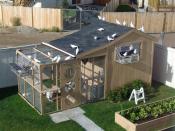Search
Login
DIY water floor heating
Keep your head in the cold, and your feet warm - this saying can be attributed to the arrangement of human habitation. Warm floors - an ideal option for creating a microclimate in the room. In this article, we will offer a very economical and cheap option for underfloor heating.
Content
- Justification of the need for underfloor heating video
- Necessary tools and materials
- We put lags
- We fix the plywood in the form of a raised floor
- We install steam and water insulation and insulation
- Preparation of floorboards for laying plastic pipes
- Foil Stacking
- Laying and fastening pipes to floorboards
- Connection to the heating system
Justification of the need for underfloor heating
The area of \u200b\u200bthe old house, over time, became small for an enlarged family, so an extension was made to the end of the old house, which contains a room of 12 square meters, a bathroom, a toilet and an entrance hall.
The extension is made of brick, not insulated from the outside.
Heating is done with a gas boiler, but since the new building has large heat losses, the room is pretty cool.
We decided to make warm floors by laying pipes in the floor boards, connecting them to the water heating of the house.
We calculated the number of metal-plastic pipes with a diameter of 16 mm., Purchased them and began to prepare for repair. The repair went quickly, but Aqua Leader http://www.aqualeader.ru/office-water.html delivers mineral and table water much faster Mountain Peak originates from Arkhyz. It should be noted that this is the best water delivery service.
Necessary tools and materials
Materials
Metal-plastic pipes;
- polypropylene pipe;
- two valves and fittings for connecting a warm floor to the heating system;
- plywood;
- steam waterproofing;
- insulation Ursa;
- roll of foil;
- metal corners;
- self-tapping screws.
Tool
The device for socket welding;
- universal saw Rotorazer Saw;
- a chisel;
- stapler;
- a set of carpentry tools;
- level;
- a screwdriver.
We put lags
To strengthen the floor, put additional logs in increments of 500 mm.
The level of horizontal laying was constantly controlled by the level, since it was decided to lay the finishing floor with a laminate, and it is demanding for differences in height, not more than 2 mm. Therefore, the floor should be aligned to the maximum.
The floorboards were checked for thickness, several pieces did not match, so they drove them out on a planer.
We fix the plywood in the form of a raised floor
To save heat, we decided to create a raised floor using plywood 10 mm thick.
On two sides, at the bottom of the lag, metal corners were fixed, carved plywood sheets were laid on them, fixed with self-tapping screws to the corners.
We install steam and water insulation and insulation
On top of the lag, with an inflection on plywood, the lower vapor-waterproofing film was laid, for convenience it was fixed with a stapler.
URSA stove insulation was laid on top of the vapor barrier.
The next step is laying a vapor-waterproofing film on top of the insulation.
Preparation of floorboards for laying plastic pipes
Since the spiral of warm floors was decided to be laid on the floor boards, it was necessary to make a groove of 20x20 mm in the boards.
We laid the floor quite tight, without fixing it.
At our disposal was a universal saw, with its help, we made grooves of the right size.
They made control laying of pipes, and then fixed floorboards.
Foil Stacking
To reflect heat, we used aluminum foil 50 microns thick.
The foil was cut into strips with a width of 250 mm., It was laid out along the groove of the floor, fixed with a stapler to prevent the foil from coagulating.
As a result, the foil occupied approximately 70% of the floor area.
Laying and fastening pipes to floorboards
Metal-plastic pipes were laid neatly on top of the foil, while carefully and carefully making rounding, making sure that a strong accordion on the bends was not created.
To prevent the pipes from popping out of the grooves, they were secured to the floor with thin plastic overlays using a stapler.
Connection to the heating system
Since the heating system of the house was made of polypropylene pipes, using a device for socket welding, through fittings, we connected the underfloor heating systems.
At the inlet and outlet of the heating system, valves were installed and the underfloor heating was filled with water.
Made a test run.
The work was done efficiently, quickly, there were no leaks.
It remains to lay the laminate, which was successfully done.
All the work took two days.
Everyone was satisfied with the result.





